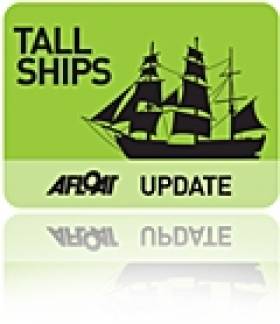Displaying items by tag: Waterford City
L.É. James Joyce Twinned With ‘Maritime’ Port of Waterford City
#OPVtwinning - L.É. James Joyce (P62) the Naval Service’s newest OPV90 / 'Beckett' class was twinned with the City of Waterford last Sunday, writes Jehan Ashmore.
The Port of Waterford was host to the event which saw Waterford City and County Council twin the L.É. James Joyce with the south-eastern maritime city. The €50 million newbuild was commissioned in September 2015 and replaced L.É. Aoife (P22) which too was twinned with the city and also from where she was decommissioned last year.
The morning twinning ceremony of L.É. James Joyce took place at the Frank Cassin Wharf on the City Quays, where the offshore patrol vessels career will be the focus of attention of the council and people.
Following the twinning, Mayor John Cummins hosted a ceremony at City Hall where among the attendees where Minister for Defence Simon Coveney, Chief of Staff Vice Admiral Mark Mellet, Officer Commanding the L.E. James Joyce, Lieutenant Commander Brian Dempsey and crew of 44 personnel along with family members.
The twinning also consolidated an existing fundraising relationship between the Naval Service and staff from the Paediatric Ward at University Hospital Waterford, who also attended the ceremony.
During the weekend, the OPV was open to the public with tours of the newbuild built by Babcock Marine & Technology, Appledore Devon. This is where the final of three OPV90 class sisters, L.É. William Butler Yeats is under construction.
Lord Nelson Heads for Waterford
As the Tall Ship STS Lord Nelson nears Carnsore Point off Wexford this evening the barque will be one of the many vessels participating in the Waterford Talls Ships Races Festival, writes Jehan Ashmore.
Joining Lord Nelson are three other UK entrants, they are the Jean de la Lune, Pelican of London and Royalist now celebrating her 40th anniversary. Together these tallships belong to the 'A' class vessels, the largest of the tallships. The impressive array of A class vessels includes four ships alone from The Netherlands with the Astrid, Eendracht, Europa and Wylde Swan, a schooner built in 1920.
From Norway is the fully rigged tallship Christian Radich and Sorlandet. The Poles are coming with their Pogoria. Neighbouring Russia are sending their impressive 108m long Mir which has 26 sails and has a 200-strong crew though the 1987 built vessel can be sailed with just 30. The final A class entrant is from outside Europe, the Columbian 1,300 tonnes Gloria, a three-master of over 60 metres long.
In addition to this exciting line-up are the 'B' and 'C' class which in total brings 45 tallships of all shapes and sizes to the quays of the River Suir. The crystal city will be host to over 1,000 trainess and over 400 professional crew who will take part in the colourful 'Crew Parade' held on Friday. For a full list of tallships and accompanying photos go to www.waterfordtallshipsrace.ie/the-race/the-tall-ships/
The spectacle of the festival will culminate in the early hours of Sunday when the fleet departs the city and heads downriver with a 'Parade of Sail' in the estuary of Waterford Harbour. As the tallships pass offshore of Dunmore East, this will mark the start of the first race-leg to Greenock.
The famous race is organised by Sail Training International (STI) a charity established to harness sail training to develop and educate young people, regardless of nationality, culture, religion, gender or social background.
The STI can trace its roots with the creation of the Sail Training International Race Committee which organised the first race of sail training tall ships in 1956. Their website is www.sailtraininginternational.org/





























































